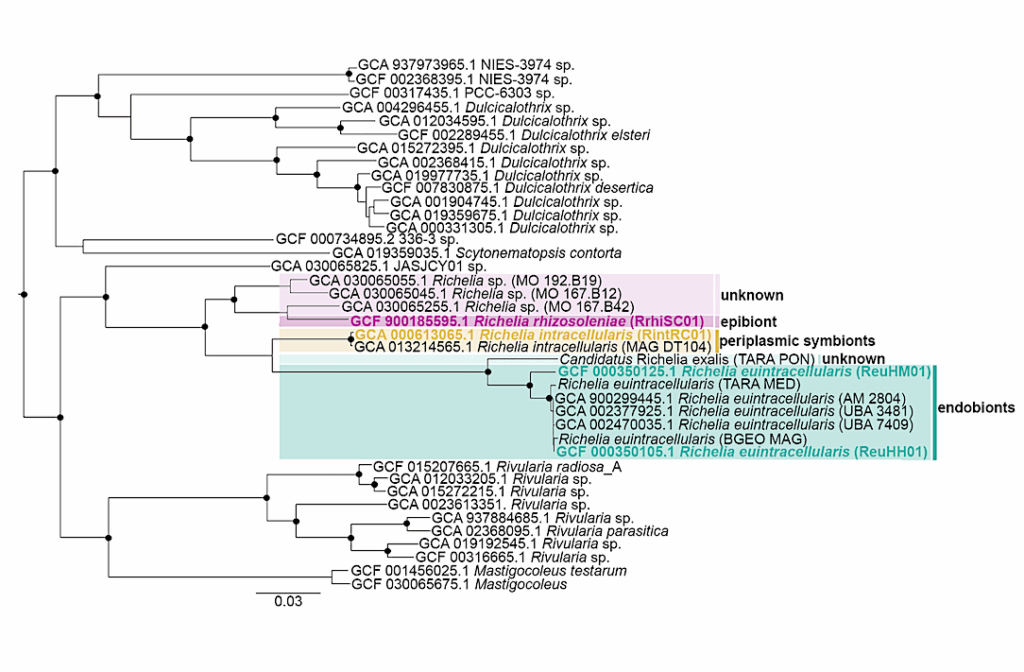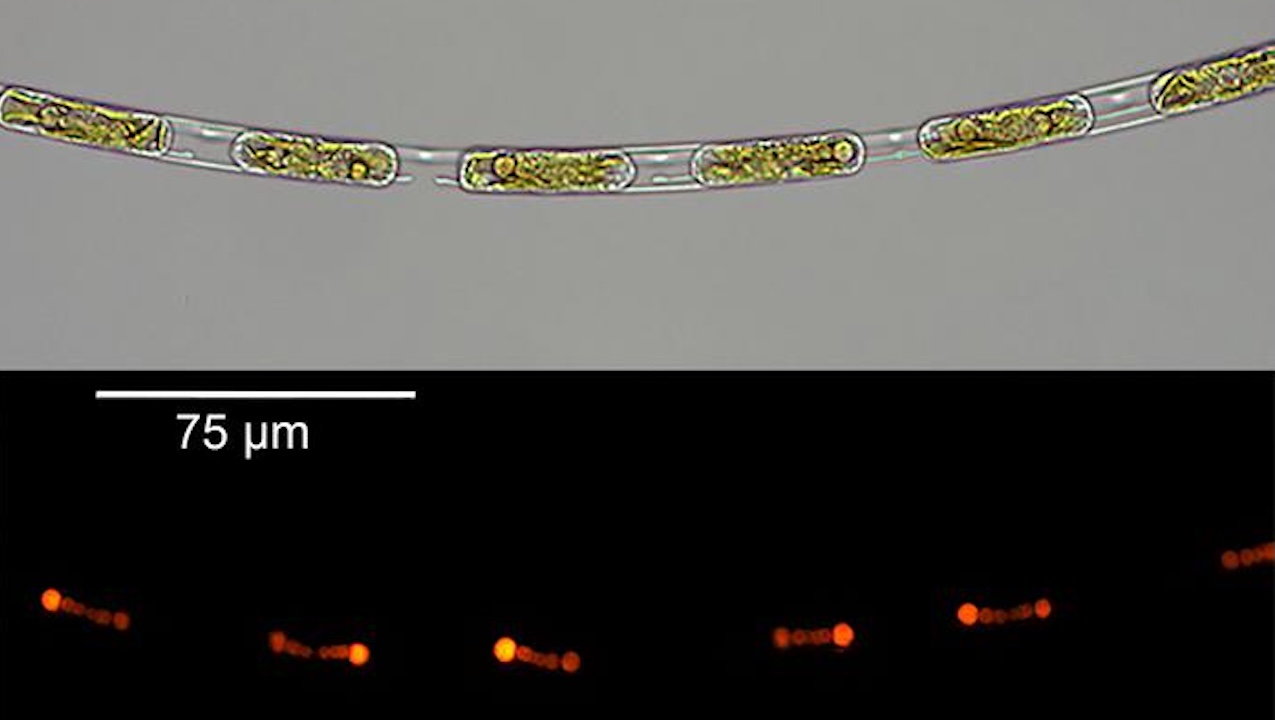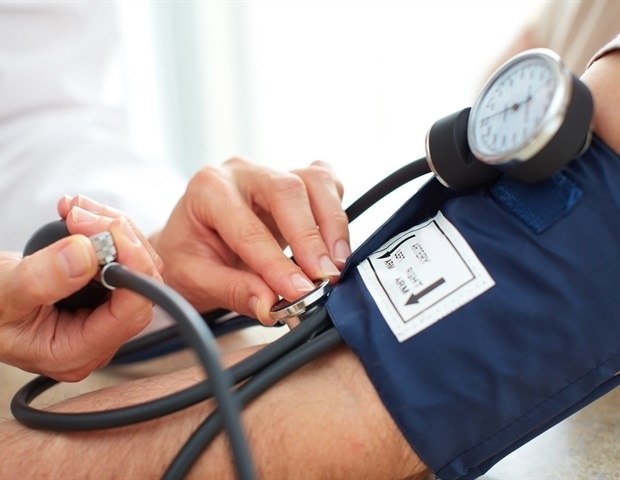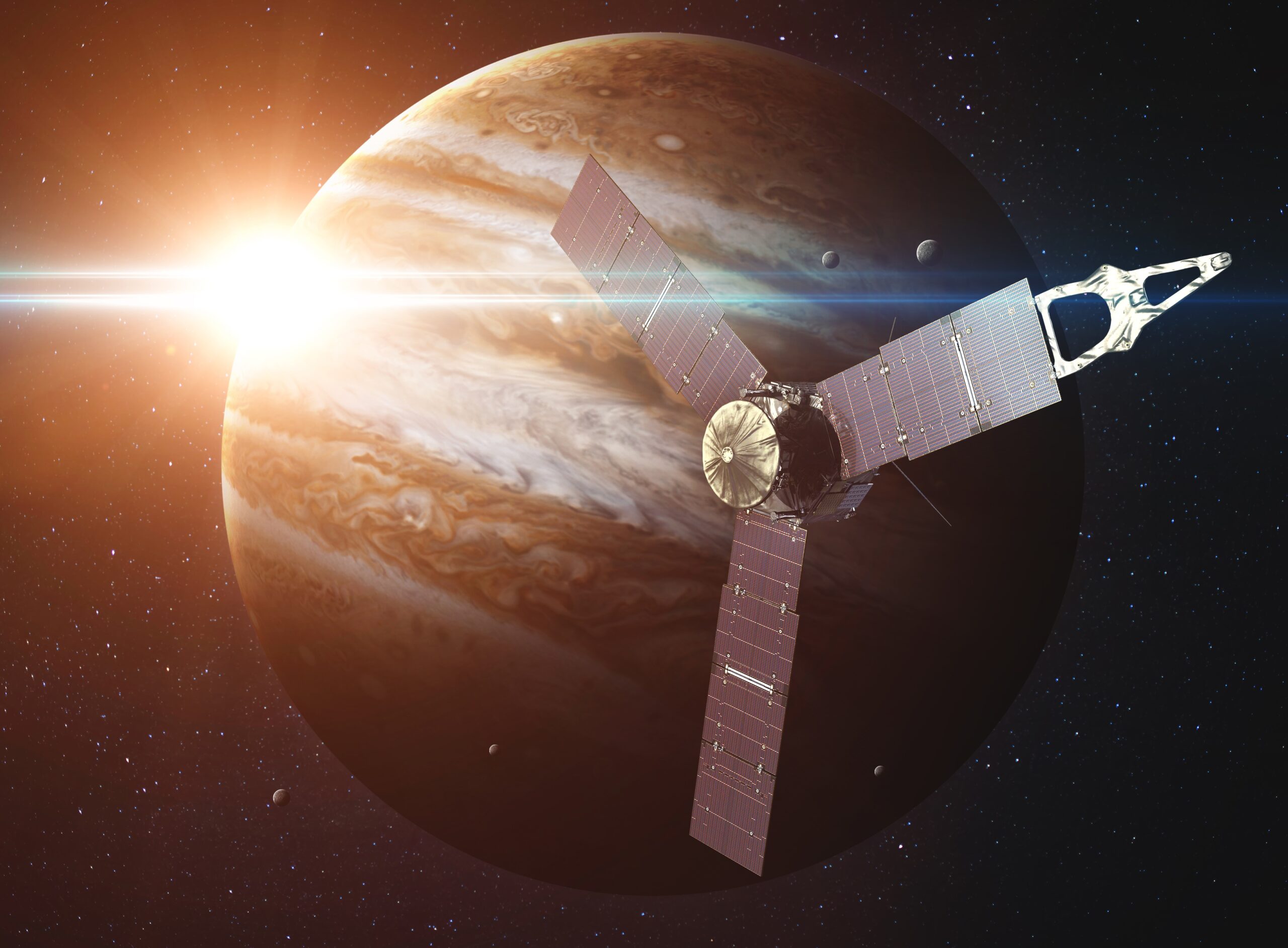Chain of the symbiotic diatom with its N2 fixing cyanobacterial symbiont. In the brightfield (top) the symbiont is inconspicuous inside the host, whereas with epi-fluorescence (bottom) the filaments of the symbionts (arrows) are easily distinguished. Credit Images by Dr. Vesna Grujcic.
The microscopic alliance between algae and bacteria offers rare, step-by-step snapshots of how bacteria lose genes and adapt to increasing host dependence. This is shown by a new study led by researchers from Stockholm University, in collaboration with the Swedish University of Agricultural Sciences and Linnaeus University, published in Current Biology.
In some of the most nutrient-poor waters of our oceans, tiny partnerships are hard at work keeping life going. These partnerships, called symbioses, are between microscopic algae known as diatoms and a specific bacteria called cyanobacteria that can take nitrogen from the air and convert it into a form that living things can use.
In some of these symbioses, the cyanobacteria belong to the genus Richelia, and their main role is to supply nitrogen to their diatom hosts. The diatom hosts are highly active photosynthesizers. Photosynthesis is the metabolic process common to all plants, algae, and some bacteria which use sunlight energy to reduce carbon dioxide (CO2) into chemical energy, usually in the form of sugars.
A continuum of integration
How the Richelia physically interact with their diatom hosts vary widely. Some Richelia live attached to the outside of their host, others live in the space between the diatom’s outer cell wall (called a frustule) and inner cell membrane, and some live fully inside. This “continuum” of integration reflects different stages of the partnerships and provides researchers with a unique opportunity to examine the evolutionary process at these different time points of their relationship.
“In general, as symbionts become more dependent on their hosts, they become more integrated into the host, for example, live inside the host cell, and start to lose genomic information that is redundant with their hosts,” explains co-author, Professor Rachel Foster at Stockholm University.
Genomes in transition
Using a comparative genomics approach, postdoctoral researcher Dr. Vesna Grujcic identified that several genomic features of the different Richelia reflect key transitional stages in the evolutionary process.
“As Richelia become more dependent to their hosts, the set of genes they carry changes a lot. We can see which genes disappear and which stay – giving us a rare view of how these partnerships evolve step by step. Moreover, by comparing Richelia to other nitrogen-fixing cyanobacterial symbionts, we found both shared patterns of gene loss and unique changes that reflect each lineage’s evolutionary path,” says Vesna Grujcic.
“What excites me most with this research is that different steps on the way to a fully integrated symbiont exist at the same time. This allowed us to study the genetics behind how evolution towards a lifestyle characterized by complete dependence of the symbiont on its host happened,” says Daniel Lundin, from Linnaeus University.
Grujcic led the pangenome analysis, identifying the set of genes shared by all Richelia (the core genome) as well as the accessory genes that differ between species. Together with Maliheh Mehrshad from the Swedish University of Agricultural Sciences, Grujcic also examined patterns of genome reduction, the size and distribution of spaces between genes known as intergenic spacers, and the extent of pseudogenization – when genes accumulate mutations and lose their function.
“The level of integration between Richelia and their hosts affects not only genome size and gene content, but also the proportion of coding regions – the parts of DNA that carry instructions for making proteins. Looking at the non-coding DNA, such as the intergenic spacers and broken genes that no longer work (pseudogenes), also tells us a lot about their evolutionary journey,” says Maliheh Mehrshad.

Coding and noncoding fractions reflect genome degradation stages in Richelia symbionts
Genome statistics were calculated for the four Richelia genomes derived from the cultures and ten MAGs (Figure 2; Table S1; Figure S1). There is a direct correlation between genome size and GC content in the Richelia spp.: endobionts possess smaller genomes and lower GC content (3.39 Mb ± 0.34 and 34.03% ± 0.88%) compared with periplasmic symbionts (5.17 Mb ± 0.78 and 39% ± 0.07%) and the epibiont (5.98 Mb and 40%) (Figure 2A; Table S1). The number and percentage of coding sequences (CDSs) follows a similar trend where genomes of endobionts have fewer CDSs (2,038 ± 175; 56% ± 4.81%) compared with periplasmic symbionts (6,029 ± 1,548; 67% ± 1.50%) and the epibiont (4,954; 76.09%) (Figures 2B, 2C, and S1A; Table S1).
The role of ‘jumping genes’
Another interesting result came from the work of the researcher Theo Vigil-Stenman, a former postdoc at Stockholm University, who characterized all the insertion sequences and transposons – pieces of DNA known as “jumping genes” because they can move genetic information within the genome.
The researchers had earlier noticed that the genome of the partially integrated symbiont which lives wedged between the outer cell wall of the diatom and the inner cell membrane, only had a slightly smaller genome than the symbiont that attaches to the outside of the host diatom and was missing similar metabolic pathways as the most internal symbiont. Typically, genome size decreases as symbionts become more integrated, or live further inside their respective hosts.
“We didn’t understand why it could maintain this genome size despite lacking several functional metabolic pathways,” reflects Foster. ”Theo Vigil-Stenman identified that these partially integrated symbiont genomes were full of insertion sequences which inflated their genome size.”
A model for studying evolution in action
The research group suggest that these diatom-Richelia symbioses represent a valuable model for studying symbiont genome evolution. The work offers a unique glimpse into evolution in action, as there are few known examples of symbioses caught in transitional stages. Such comparative analysis is rare among planktonic systems and places the diatom–Richelia partnership alongside other notable models of symbiosis.
Much remains however to learn about how living in symbioses has impacted the evolutionary trajectory of the host diatom genomes and how such models of N2 fixing symbioses can be used in other fields. For example, can such systems lend valuable insights to synthetic biology for making N2-fixing crops?
Stepwise genome evolution from a facultative symbiont to an endosymbiont in the N2-fixing diatom-Richelia symbioses, current biology
Astrobiology,


















